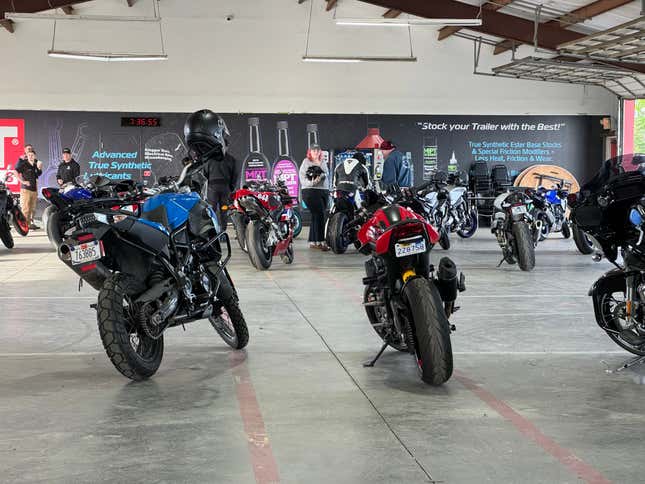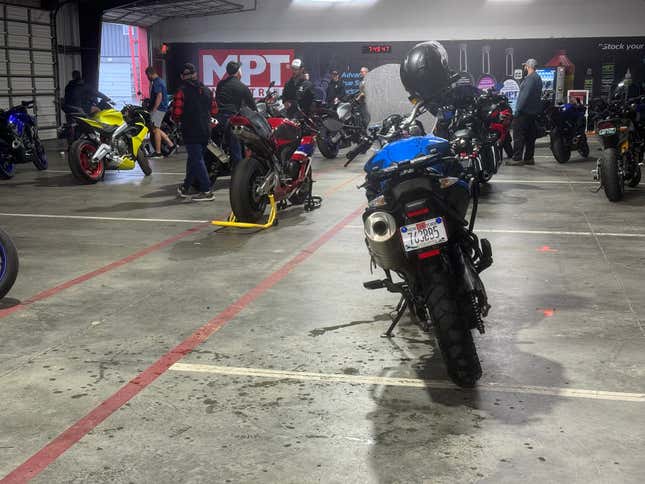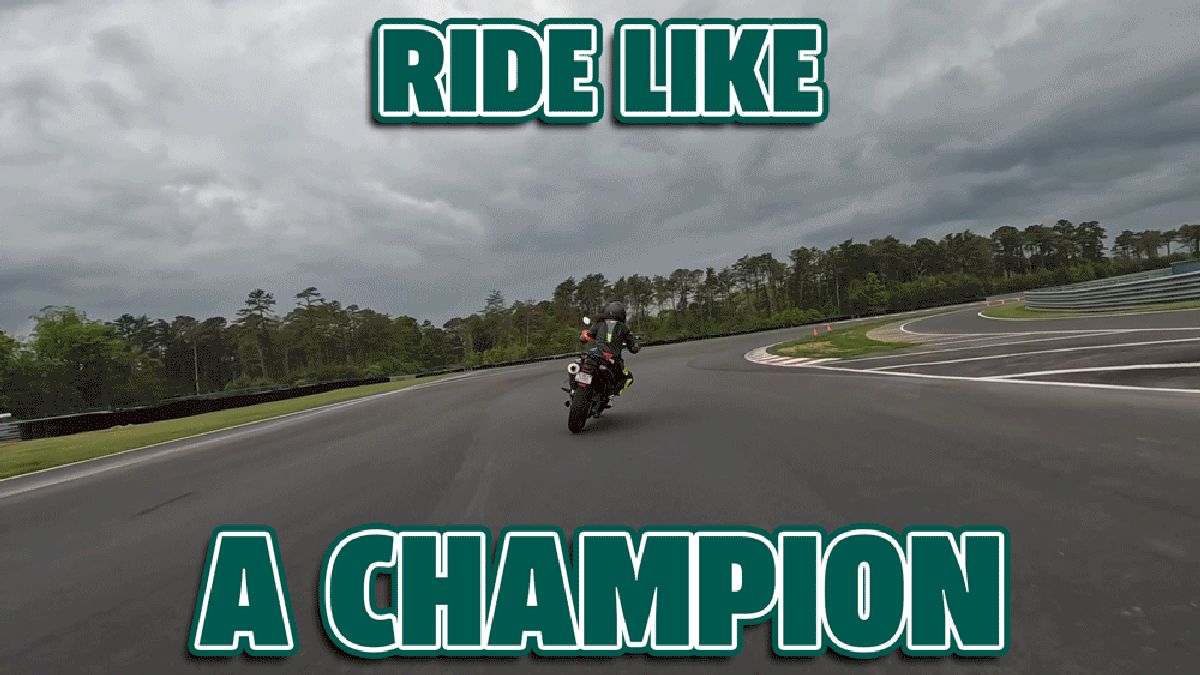When someone mentions “motorcycle school,” your first thought is probably of the Motorcycle Safety Foundation’s Basic RiderCourse — the weekend-long training that gets you a shiny new M endorsement on your license. It’s a good course, a useful course, but it’s only the start. Where do you go from there?
Well, if you’re a motorcycle journalist who’s held up the pack one too many times on bike launches, you might head to Yamaha Champions Riding School. ChampSchool, as it’s more commonly called, takes riders from the parking lot to the race track to teach all those details you can’t learn at low speeds. For an urban rider like me, ChampSchool completely changed my riding.
Full Disclosure: Yamaha gave me a spot in ChampSchool at New Jersey Motorsport Park. The company provided the track time, instruction, and most of my meals, as well as offering gear rentals (for which I paid). Jalopnik covered my lodging, and I covered my own transportation by being the only student in the class dumb enough to ride to the school as well as at it.
How I Rode Before ChampSchool
For most of my motorcycling career, I’ve been an urban rider. Besides brief trips out to visit family in the suburbs, or the occasional concussion-laden off-road excursion, I’ve always ridden either downtown Rochester or the five boroughs of New York City.
This has left me with a deeply weird motorcycling skillset. Thanks to a life lived stoplight to stoplight, I’m adept at fine clutch control — highly practiced at those footless stops that I once found so daunting — but I’m still a novice to the whole “turning” thing. In New York, turns are right angles at slow speeds — if not entirely stopped, waiting for TikTok-scrolling pedestrians to meander their way through a crosswalk.
I hadn’t really thought of this as a limitation until I started attending motorcycle launches for Jalopnik. Suddenly, I realized I was slow in the corners — not just compared to motorcycle YouTubers with view count-centric death wishes, but compared to regular traffic. The first time I was passed by a frustrated Mercury Grand Marquis in the California canyons, I realized I had more to learn. I needed a teacher.

How ChampSchool Works
My ChampSchool experience was a bit of an odd one, since I was a late signup to the class at New Jersey Motorsports Park. This meant that the school was already full up on rental bikes — rather than an R3 or R7, I attended on my own BMW F800GS. What’s more track-ready than an 11-year-old adventure bike with a tractor-like engine and $100 dual sport tires?
Shockingly little, as I found out on the first of two days at NJMP. Day one of the course began slowly: tech inspection, intro-to-the-race-track instructions that would be familiar to any HPDE participant, then laps in instructor-driven Chrysler Pacificas. Here, the race track wasn’t the point — all the familiarizing was to ensure that it wasn’t what we were thinking about once we got on the bikes.
Instead, the ChampSchool instructors wanted us thinking about technique — braking technique and body position technique, most of all. Instructors taught not only how to use small amounts of front brake to load the tire and suspension, but why the front end needs that little bit of pre-loading before you go grabbing the lever with all your might. We were taught not just to lean our upper bodies off our bikes, but to hang off them from our inside thigh.
Classroom instruction gave way to lead-follow training, followed by on-track drills. The on-track section of the day ended with students running laps while instructors followed and filmed, so we could all watch just how bad we were over dinner. This was the part of the school where I learned that passing Ducatis on your slow ADV doesn’t necessarily mean you’ve got good technique — just that you seem to fear death less than the other riders.
Retiring to my hotel room later that night, finally bothering to look up the speed rating on my tires, and finding it to be less than the speeds I was hitting on the front straight — in the rain, immediately before heavy braking into Turn 1 — made me realize I could stand to fear death a little more, actually.

The Class Continues
Day two started how day one ended: Wet. Even wetter than the first day, as I found out riding from the hotel to the track, which put a damper on confidence early in the morning. Yet, whether by coincidence or through a seamless pivot from the instructors, the lesson plan seemed perfect for the conditions — focusing on ways to think about the racing line that required less time on the side of the tire.
Even if we students weren’t shaving down our lap times the same way we had on day one, the wet conditions never stopped us from learning. Braking precision, body position, ways of thinking about a motorcycle’s strengths and weaknesses and abilities. So much of what Champ School teaches is mental, a wet track almost doesn’t matter.
This, of course, is the point. Champ School may take place on a track, but it doesn’t aim to just be a track school — it’s about improving your ability to ride, regardless of when or where or why. In fact, the course often makes mention of real-world reasoning behind the lessons it teaches, with considerations made for uneven pavement or blind corners at intersections.
How Champ School Changed My Riding
It’s that mental side, in the end, that truly made a difference in my riding. I still live in Brooklyn, I still don’t have many corners to carve, but the way I look at any turn has been fundamentally altered. My relationship to leaning a bike, all that muscle memory developed from mountain biking that made me ride pavement like it’s dirt, has been rewired into something smoother, safer, and faster.
Of course, all that theory on the mental side doesn’t mean much without the physical proof that it works. That’s where the track time is crucial: It’s a (comparatively) safe environment, where you can push a motorcycle to levels that make good technique a necessity. At New Jersey Motorsport Park, I could not only understand how to change my riding, but feel how much better a lap went after making those changes. That’s the kind of experience you can’t get in a parking lot, and really shouldn’t get out on the road.
Champ School made me a better motorcyclist. Unequivocally, undebatably, without question or doubt or hyperbole. Whether it’s for any rider is up to that rider’s individual needs, wants, and budgets, but I an say that it’s made more of a difference for me than anything since my first-ever MSF. And, next time I see that Grand Marquis, I’ll show it who’s boss.

